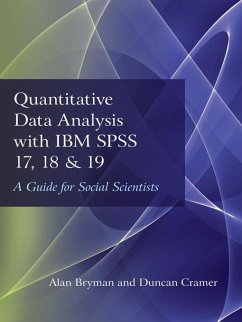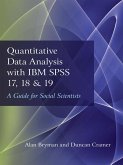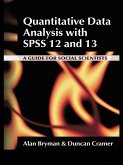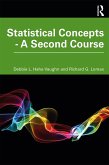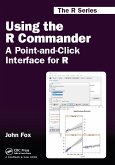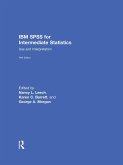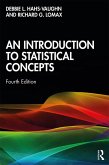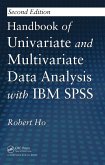As with previous editions, Alan Bryman and Duncan Cramer continue to offer a comprehensive and user-friendly introduction to the widely used IBM SPSS Statistics. The simple, non-technical approach to quantitative data analysis enables the reader to quickly become familiar with SPSS and with the tests available to them.
No previous experience of statistics or computing is required as this book provides a step-by-step guide to statistical techniques, including:
- Non-parametric tests
- Correlation
- Simple and multiple regression
- Analysis of variance and covariance
- Factor analysis.
This book comes equipped with a comprehensive range of exercises for further practice, and it covers key issues such as sampling, statistical inference, conceptualization and measurement and selection of appropriate tests. The authors have also included a helpful glossary of key terms.
The data sets used in Quantitative Data Analysis with IBM SPSS 17, 18 and 19 are available online at http://www.routledgetextbooks.com/textbooks/_author/bryman-9780415579193/; in addition, a set of multiple-choice questions and a chapter-by-chapter PowerPoint lecture course are available free of charge to lecturers who adopt the book.
Dieser Download kann aus rechtlichen Gründen nur mit Rechnungsadresse in A, B, BG, CY, CZ, D, DK, EW, E, FIN, F, GR, HR, H, IRL, I, LT, L, LR, M, NL, PL, P, R, S, SLO, SK ausgeliefert werden.
"Bryman and Cramer's Quantitative Data Analysis has long been one of the best texts in the field. Crucially it explains why something is done, as well as how. Most importantly it does it without recourse to daunting formulae and calculations. It takes students from the beginnings of data analysis, assuming no knowledge of either statistics or SPSS and by the end of it a student can be an accomplished analyst." - Malcolm Williams, Director, Cardiff University. School of Social Sciences, UK
"Bryman and Cramer's Quantitative Data Analysis has long been one of the best texts in the field. Crucially it explains why something is done, as well as how. Most importantly it does it without recourse to daunting formulae and calculations. It takes students from the beginnings of data analysis, assuming no knowledge of either statistics or SPSS and by the end of it a student can be an accomplished analyst." - Malcolm Williams, Director, Cardiff University. School of Social Sciences, UK

